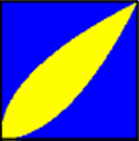 |
Designing Tiles |
 |
Designing Tiles |
Description of the Project
Kenyon College is building a new state-of-the-art Fitness and Recreation Center, and the College is seeking your help with the design of the Center's new Olympic-sized swimming pool. In particular, Kenyon needs your help in designing the tiling pattern that will cover the walls and floor of the pool. The glass tiles, called "smalti" will be 1-inch square tiles. The tiles will be either solid blue in color or blue and gold. (The gold portion will consist of clear glass with fused gold inside.) While the College is seeks an interesting pattern for its pool, there are some practical and budgetary constraints for this project. To this end, your design must meet the following specifications:
Other Relevant Information:
The pool will be 169' 3.5" long and 75' 1.5" wide. So the total water surface area will be 12,718 square feet. (To get a feel for how big this is, 3- and 4-bedroom homes often run around 2000-2400 square feet in total surface area!) The pool will be 4 feet deep at the shallow end and will reach its greatest depth of 13.5 feet midway down the length of the pool, where the diving boards will be located. The depth at the deep end of the pool will be 10.5 feet. The total number of tiles needed to cover the sides of the pool is 610,000, and the total number needed for the floor is 1,910,000. Hence the number of tiles in total is 2,520,000. (This number includes the extra tiles needed to account for human error along the way.)
Example. The tile pictured to the right has three simple regions defined by the two functions:
|
 |
||||
Sample Tiling Patterns: A single tile can produce many different floor plans. Feel free to rotate and translate your tiles when you design your pattern. However, keep in mind that symmetric patterns are usually more pleasing to the eye than patterns without symmetry. Below are several examples.
The code used to produce the graphics above is included here: DesigningTiles.mws. This code is easily adapted to other tile designs that share the same type of symmetry. However, if you want to use MAPLE to produce a tiling pattern having a different symmetry than those shown above, then you will need to have some programming experience (in particular, the iterated "do loops" can get a bit complicated). |
|||||
Acknowledgement
This project is an adaptation of a project written by John Ramsay (Wooster College) published in Problems for Student Investigation, MAA Notes #30.